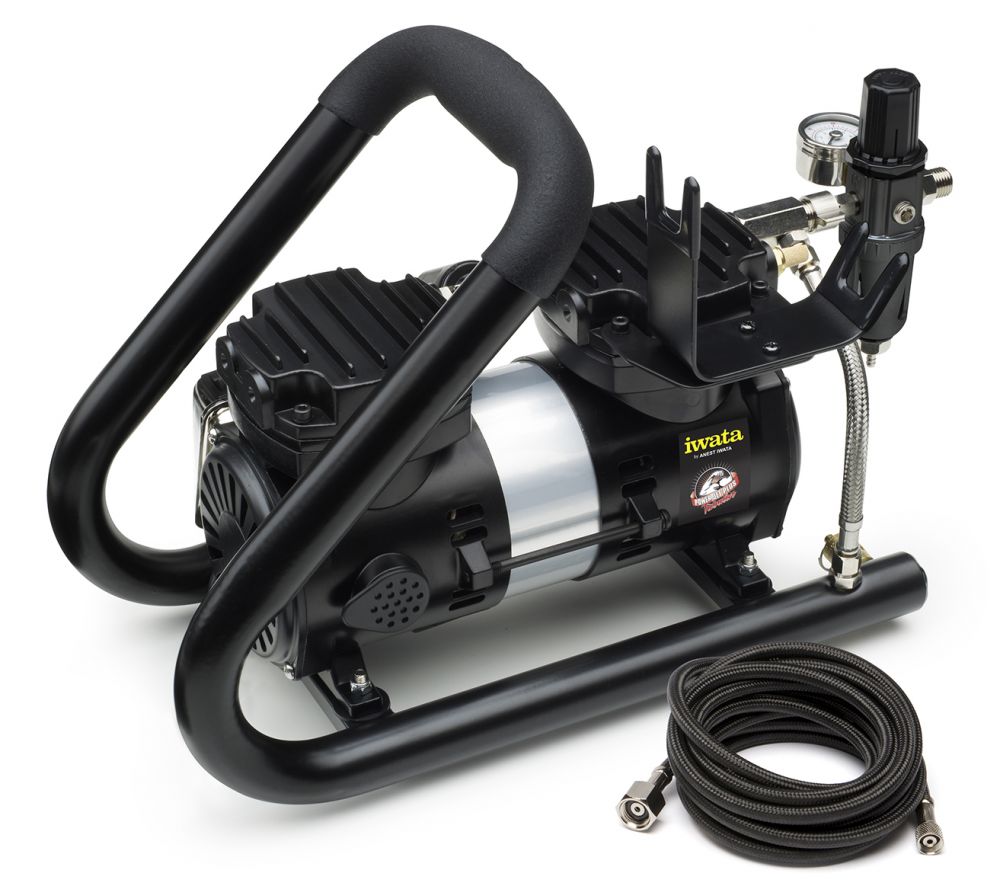27 November 2020
|
compressed into one article by Airbrushes.com

Choosing the right airbrush for painting miniatures is key to getting that perfect finish, but your choice of air source is just as important. If you do not have an adequate supply of air for the job you want to do, your airbrush will not perform properly.
Here are some of the key features you’ll want to consider before buying a compressor….
Air Pressure (PSI):

Air pressure is rated in pounds per square inch (PSI) It is the amount of force (or weight) in pounds applied by the air pushing onto an area of one square inch.
Airbrushes.com offer a full assortment of air compressors from light-duty, miniature models to larger-scale, more powerful options. As a general guideline, miniature or small compressors are intended for light duty use at low air pressures. When spraying for extended periods of time or when higher pressures are desired, a mid-range to larger compressor is required.
Did you know? Iwata airbrushes atomise well at low pressures, extending your choice of air source to the smallest compressors. An Iwata airbrush can atomise well at just few psi! Generally, for most modelling applications you will be operating between 10 psi and 30 psi and you will need to experiment with your preferred pressure for your paint mix, atomisation and desired control over speed of working.
Duty Cycle:

Knowing the duty cycle is very important before you buy a compressor. This determines how long you can run the compressor continuously. If you exceed the duty cycle, the pump will get too hot and won’t last as long as it should.

Therefore, even on our largest compressors that can run for 60 minutes continuously (which is a lot of time when you’re airbrushing models!), we suggest allowing the motor to rest for at least 20 minutes after each cycle of continuous use.
Does my compressor need an air tank?
The answer is no. A compressor tank doesn’t produce air; it only stores air. If you are producing as much air as you want to use, you’ll never run out of air, no matter how small the tank is. Many compressors designed for hobby use don’t have a tank and if you choose one of good quality such as an Iwata Studio Series you won’t get any 'pulsing' of air.
With this said, a storage tank does have its advantages. The air tank will trap more condensation than a filter alone, so compressors with tanks deliver cleaner, drier air resulting in a smoother, more controllable airflow. Also, an air storage tank means the compressor motor will not turn on and off as often, so this results in less noise and longer life of the motor.
An Iwata 'Handle-Tank' compressor has an air tank (0.5 litre) built into its tubular handle, also serving as a carry handle for easy mobility!
Automatic / Auto-Stop Switch:
Usually present on compressors with a tank, but also on some without tanks. An auto-stop (also known as 'Smart Technology') switches the motor off when a maximum pressure in reached, and back on again when the pressure drops to a minimum pressure. These machines can be left on and will begin to run again only when required. This means less motor wear and less noise. These are a good solution for longer periods of usage or a busy professional environment.
Air Regulator:

An air regulator is an extremely important feature on a compressor. It allows adjustment of the air pressure supplied to the airbrush. Many regulators have a gauge that allows you to read the PSI. Ideal psi is determined by the airbrush, viscosity of spray material being used, user preference and in some cases by the application.
Moisture Filter:

A moisture filter removes water/condensation from the air supply. Condensation coming through your airbrush, mixed with the paint medium can cause spattering or a streaky application. The moisture filter will also act as a small reservoir on a tank-less compressor, which evens out the airflow so there is no pulsing.
Note: You need to press the moisture release on the filter regularly to avoid excessive build-up of trapped condensation.
Moisture is more of a problem in colder, humid climates such as the UK, where a moisture filter is essential for all but the smallest compressors.

If you have a small compressor with no built-in moisture filter, or even if your compressor does have a moisture filter, you can add an end-of-line moisture filter at the airbrush end of the hose as a last line of defence to trap the last few drops that condense in the air hose as the compressed air cools on its way to the airbrush.

Airbrushes.com rate Iwata products highly and with 70 years in the airbrush industry, we know a good product when we see one. But we don’t just sell Iwata, we have an extensive range of quality brands and products, with the knowledge to support. Check out our full range of compressors.
The newly launched Sparmax Quantum Orange Compressors feature everything you need for hobby painting to high volume spraying, finished in a striking Orange Metallic Pearl colour. Both models feature a 2.5L air tank and include 2 Braided Hoses and 2 Quick Release set ups to disconnect your hose with ease. Exclusive to Airbrushes.com and our resellers.
Pairing your airbrush and compressor


Some low to medium quality brands tend to be 'gustier' on air, requiring more air volume and therefore larger, more powerful and noisier compressors. While higher quality airbrushes such as Iwata and Sparmax need less volume of air and can atomise using lower pressures, taking out the need for a large, expensive compressor. This also means that any of our Iwata airbrushes can run from any of our Iwata compressors (unless our website states differently).
Want the ease of a one-box option? Our kits include an Iwata airbrush and compressor plus an assortment of extras to get you started: Find them here









